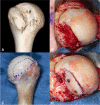Management of Shoulder Instability in Patients with Seizure Disorders
- PMID: 37067689
- PMCID: PMC10188738
- DOI: 10.1007/s12178-023-09833-3
Management of Shoulder Instability in Patients with Seizure Disorders
Abstract
Purpose of review: Patients with seizure disorders commonly suffer shoulder dislocations and subsequent instability. Due to high rates of recurrence and bone loss, management of this instability and associated pathology has proven to be more complex than that of patients without seizure disorders. The ultimate goal of this review is to outline the various treatment modalities and their respective outcomes in this complex patient population.
Recent findings: Optimization of medical management of seizure disorders is imperative. However, despite these efforts, the incidence of post-operative seizure activity continues to be a concern. These subsequent episodes increase the risk of further instability and failure of surgical procedures. Overall, the use of soft tissue procedures has proven to result in increased recurrence of instability compared to bone-block augmenting and grafting procedures. There are a variety of bone-block procedures that have been described for anterior and posterior instability. Despite their success in decreasing further instability, they are associated with several complications that patients should be informed of. There is no consensus regarding the optimal surgical management of shoulder instability in patients with seizure activity. A multidisciplinary approach to the management of the seizure activity is paramount to the success of their treatment. Further studies are required to evaluate the optimal timing and type of surgical intervention for individualized cases.
Keywords: Bone graft; Epilepsy; Seizure; Shoulder; Shoulder dislocation; Shoulder instability.
© 2023. The Author(s), under exclusive licence to Springer Science+Business Media, LLC, part of Springer Nature.
Conflict of interest statement
No author has any financial or non-financial interests that are directly or indirectly related to the work submitted for publication.
Figures




Similar articles
-
Management of bipolar shoulder injuries with humeral head allograft in patients with active, uncontrolled seizure disorder: case series and review of literature.JSES Int. 2021 Oct 21;6(1):132-136. doi: 10.1016/j.jseint.2021.09.001. eCollection 2022 Jan. JSES Int. 2021. PMID: 35141687 Free PMC article.
-
Surgical Stabilization of Shoulder Instability in Patients With or Without a History of Seizure: A Comparative Analysis.Arthroscopy. 2020 Oct;36(10):2664-2673.e3. doi: 10.1016/j.arthro.2020.05.048. Epub 2020 Jun 12. Arthroscopy. 2020. PMID: 32540371 Free PMC article.
-
Effectiveness of Latarjet for anterior shoulder instability in patients with seizure disorder.JSES Int. 2020 Dec 10;5(2):171-174. doi: 10.1016/j.jseint.2020.09.020. eCollection 2021 Mar. JSES Int. 2020. PMID: 33681833 Free PMC article.
-
Iliac bone-block autograft for posterior shoulder instability.Orthop Traumatol Surg Res. 2009 Apr;95(2):100-7. doi: 10.1016/j.otsr.2008.09.008. Epub 2009 Mar 21. Orthop Traumatol Surg Res. 2009. PMID: 19332402 Review.
-
[Treatment strategy in first traumatic anterior dislocation of the shoulder. Plea for a multi-stage concept of preventive initial management].Unfallchirurg. 1998 May;101(5):328-41; discussion 327. doi: 10.1007/s001130050278. Unfallchirurg. 1998. PMID: 9629045 Review. German.
Cited by
-
Chronic anterior shoulder instability with bone loss: a practical approach.Ann Jt. 2024 May 20;9:26. doi: 10.21037/aoj-23-8. eCollection 2024. Ann Jt. 2024. PMID: 39114412 Free PMC article. Review.
-
Arthroscopic suture bridge fixation for acute bony Bankart with anterior glenohumeral instability: a case report and narrative review.Ann Jt. 2024 Apr 10;9:16. doi: 10.21037/aoj-23-46. eCollection 2024. Ann Jt. 2024. PMID: 38694813 Free PMC article. Review.
-
Chronic recurrent shoulder instability treated with a hemiarthroplasty, Glenojet allograft glenoid reconstruction, and anterior capsular reconstruction: a case report.JSES Rev Rep Tech. 2024 May 25;4(3):493-498. doi: 10.1016/j.xrrt.2024.05.004. eCollection 2024 Aug. JSES Rev Rep Tech. 2024. PMID: 39157242 Free PMC article. No abstract available.
-
Clinical, Diagnostic, and Therapeutic Characteristics of Posterior Glenohumeral Instability.Arch Bone Jt Surg. 2024;12(12):820-825. doi: 10.22038/ABJS.2024.81046.3697. Arch Bone Jt Surg. 2024. PMID: 39720546 Free PMC article. Review.
-
Distal Radius Allograft for Glenoid Reconstruction in Anterior Shoulder Instability With Significant Glenoid Bone Loss.Arthrosc Tech. 2024 Sep 28;14(2):103242. doi: 10.1016/j.eats.2024.103242. eCollection 2025 Feb. Arthrosc Tech. 2024. PMID: 40041355 Free PMC article.
References
Publication types
LinkOut - more resources
Full Text Sources
Research Materials

